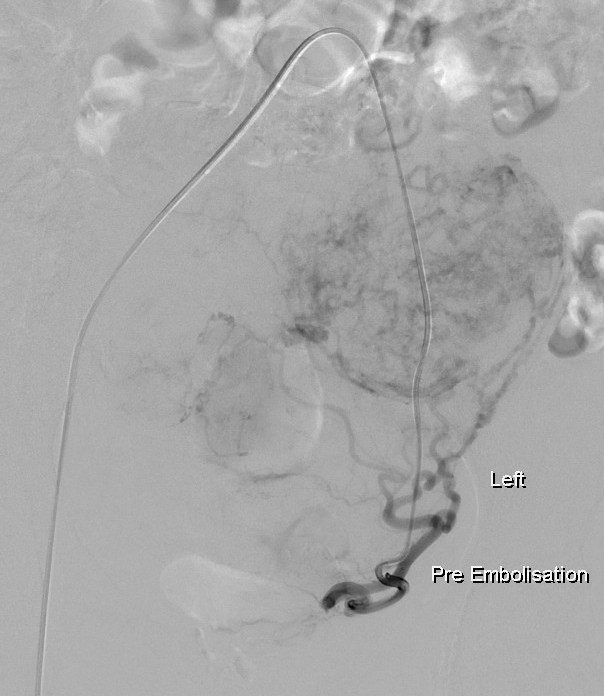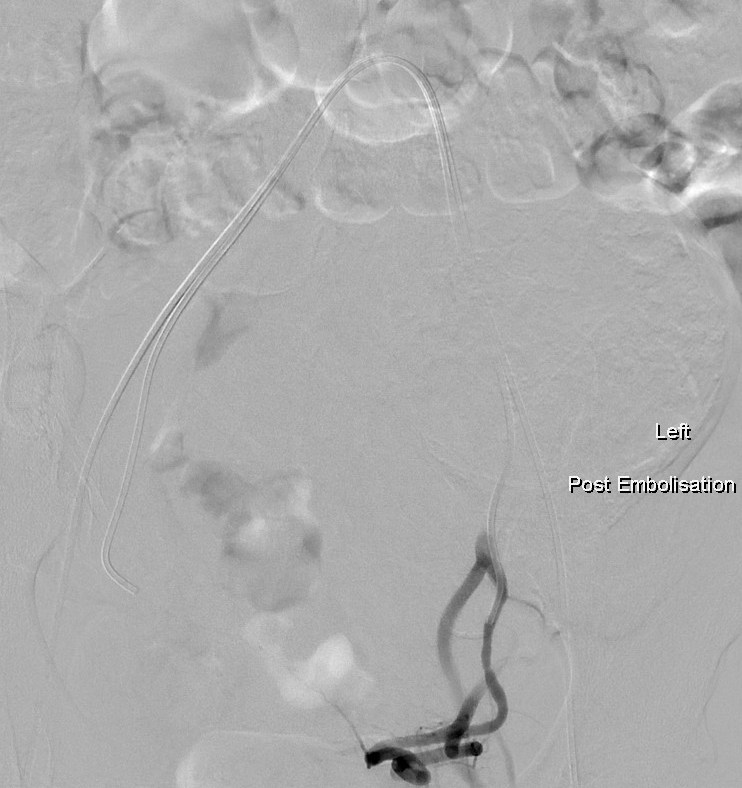Uterine Artery Embolisation (UAE), also known as Uterine Fibroid Embolisation (UFE), is an image-guided, minimally invasive procedure used to treat patients with symptomatic uterine fibroids.
An interventional radiologist, a specialist in performing these procedures, uses a high-definition x-ray camera to guide a catheter with a diameter of about 2 mm into the uterine arteries to deliver particles of an embolic material. The particles lodge in the small vessels supplying the fibroids reducing their blood supply and causing them to shrink.
Several different types of embolic materials are used for UAE. They function in the same way, but differ in their composition, for examples:
- polyvinyl alcohol, a plastic material resembling coarse sand
- Gelfoam®, a gelatin sponge material
- microspheres, polyacrylamide spheres with a gelatin coating
Key features of UAE/UFE procedure
| Summary of key features |
|
What situations prevent me from having UAE/UFE for fibroids?
Situations that prevent you from having UAE include pelvic infection, severe allergy to the contrast material to be used in the procedure, arteriovenous shunting, an undiagnosed pelvic mass, coagulopathy (clotting disorder and bleeding disorder), inefficient kidney function, a history of pelvic radiation and genital tract malignancy.
What are the risks or complications of the procedure?
As with any procedure, there are risks and potential complications associated with it.
| Summary: Risks/complications of UAE | |
| Ovarian failure | Despite all measures being taken, the injected particles may travel to the ovaries. This may cause the ovaries to stop working temporarily or permanently, resulting in early menopause. |
| Infection | Not common but can be potentially serious. This may occur in the degenerating (dying) fibroids, anything up to several months after the procedure.
Serious infection of the uterus can lead to emergency hysterectomy. Signs of uterus infection are: severe pain, sweating and a high fever. |
| Vaginal Discharge | May happen for some weeks up to several months. Discharge is a result of dead fibroid tissue being expelled from the womb. Sometimes, this appears as whitish stringy material mixed with blood clot at the time of a period. This is not a cause for concern. |
| Post Embolisation Syndrome | Mild flu-like symptoms, sometimes with a low temperature, which is caused by the fibroids dying away. This typically occurs within 4 days after the procedure and should not last more than a week. Simple pain killers may help. |
| Embolism | Blood clots in the lungs and arteries may rarely occur. |
| Groin haematoma | Bruises at the site of entry of catheter. |
| Perforations | Puncture of the major arteries due to the guide-wire. |
Am I the right candidate for UAE/UFE procedure?
The radiologist carries out a MRI scan to determine the size and location of the fibroids and to exclude other conditions that can mimic fibroids. This helps to determine whether you are suitable for UAE treatment.
How do I prepare for the procedure?
A practical step-by-step approach includes:
- You must stop blood-thinning medicine starting 5 days before the procedure. You are also advised to stop taking aspirin, nonsteroidal anti-inflammatory drugs (NSAIDs) for examples ibuprofen (Nurofen), naproxen, diclofenac.
- You must inform the hospital if you have any allergies, especially to local anaesthetic medications or to contrast materials (also known as "dye" or "x-ray dye").
- If you have a coil (IUCD) fitted for contraception, inform the hospital or your GP about it. It is best to remove the coil before the UAE procedure in order to reduce the risk of infection.
- You are required to have 4 hours of fasting (no food) before the procedure, although it is alright to drink some water.
- If you are diabetic, on the day of the procedure, you should stop Metformin if you use this medication but you can continue your regular insulin .
- On the day of the procedure, you are required to shave the skin around the groin area where the artery is.
What happens BEFORE the procedure?
You may expect the following:
- Blood sample is taken to measure FSH hormone as a baseline for ovarian function.
- Pregnancy test is carried out.
- You will lie flat on your back on the X-ray table.
- A bladder catheter may be fitted.
- An IV (intravenous) line in one of your arms is inserted through which sedative or pain killers will be given. You will be sedated lightly for the procedure so that you are awake but not actively so.
- A monitoring device is attached to your chest and finger and you may be given oxygen through small tubes in your nose.
- Antibiotic injections and suppositories may be given to help to prevent infection.
What happens DURING the procedure?
- Local anaesthetic is injected in the groin to numb the skin. The injection can cause some stinging initially but the area will then go numb.
- Throughout the procedure, a nurse will be with you to monitor your pulse and blood pressure and may give you oxygen if appropriate.
- The interventional radiologist places a catheter into an artery in the leg (femoral artery) through a nick in the skin and dye (contrast material) will be injected to obtain the "roadmap" for the catheter. You may get a hot feeling in the pelvis as the dye goes in.
- Using x-ray imaging, he/she steers the catheter towards the blood vessels of the womb feeding the fibroids. Once in a safe position, the radiologist slowly injects tiny embolic particles to block off these blood vessels. The result is the starvation of the fibroid leading to its shrinkage.
- Both arteries feeding the womb are embolised even if the fibroids are confined to one side. This is necessary to prevent the "unembolised" artery from taking over the blood supply to the fibroids.
- Once x-ray confirms successful embolisation, the catheter is removed and pressure is applied over the groin area for approximately 5-10 minutes to stop any bleeding. No sutures/stitches are needed.
- Your intravenous line is removed. The whole procedure usually takes approximately 1 -2 hours.
The UAE Procedure is shown in the diagram below:

What happens AFTER the procedure?
- You return to the ward, your blood pressure and pulse are monitored as routine observations and frequent checks are made for signs of bleeding from the skin entry point.
- You are required to lay flat for a few hours (at least 4 hours) to reduce the risk of bleeding from the puncture sites in the groins.
- The ward starts your post-operative analgesic pain regimen as you may experience mild pain to severe crampy, period-like pain during the first 24 hours which tends to be worst in the first 12 hours. Expect some pain to still be there by the time you are being discharged home.
- It is normal for you to spend a night in hospital and you are ready to go home by lunchtime the next day. Hospital stay may in some cases extend to 2 nights.
- On discharge, you are given pain relieving tablets to take home.
- You will have a follow up ultrasound scan in 3, 6 months and MRI scan in 12 months.
Care At Home Guide
- You may feel very tired for up to 2 weeks. Rest for 3-4 days. Most women return to work within one or two weeks.
- Do not drive for 48 hours.
- Keep the puncture site cleaned to prevent infection and help healing.
- Mild oozing from wound site may appear which is normal. Tenderness may last for a week, bruising may go on to 2 weeks and a small lump may appear which can last up to 6 weeks.
- If you have a slight fever after the procedure, do not worry, it is a sign that the fibroid is breaking down.
- It is common for you to see bloody vaginal discharge for 2 weeks but this can last up to several months. Use sanitary towels for at least 4 weeks in order to reduce the risk of infection.
- You can resume normal activities when you feel you are able to. Allow yourself 10 days off for complete recovery.
- It is advisable to use condoms or a diaphragm for at least 4 weeks if you are sexually active.
You are required to seek immediate medical attention if you experience any of the following symptoms:
- Feel very unwell.
- Intense pain.
- High fever & sweating.
- Pelvic tenderness.
- Bad smelling or offensive vaginal discharge.
Frequently Asked Questions on UAE
Q1. I am on Zoladex, what should I do BEFORE starting UAE/UFE procedure?
With regards to Zoladex or any GnRHa, the fibroids return quickly to their original size after cessation. However, it is probably advantageous to the interventional radiologist that the fibroids do become vascular again so that the embolisation particles can adequately penetrate the fibroids. There is no advantage to 'capitalising' on the size reduction as one may have thought. We recommend stopping Zoladex at least 2 weeks prior to UFE.
Q3. How should I expect my periods to change after the procedure?
Your period should gradually return to a more normal frequency with reduced flow. Occasionally, you may miss a cycle or two or even rarely stop having periods altogether.
Q4. What is the risk of early (premature) menopause?
About 1-5% of women become menopausal after UAE procedure, probably due to some embolic particles reaching the ovaries. The risk of developing premature menopause is higher in women aged over 45 years.
Q5. How soon will I notice an improvement in symptoms after the procedure?
It usually takes 2 to 3 weeks to notice the relief of bulk-related symptoms and improvement occurs over a period of months as the fibroids continue to shrink and soften. By six months, the process has usually finished and the amount of symptom improvement will stabilise.
Q6. What happens to my fibroid(s) after UAE?
Fibroids within the womb cavity may be expelled through the vagina as whole or pieces of tissue. Expulsion usually occurs 6 weeks to 3 months afterwards. When this happens, you are likely to feel period-like pain and have some bleeding.
Q7. Should I be concerned about the effect of x-ray exposure during UAE on my uterus?
You are exposed to x-rays during UAE, but the exposure levels usually are well below those levels where adverse effects on the patient or future childbearing would be a concern.
Q8. I have experienced some leg pain after UAE/UFE procedure. Should I be concerned and how can one exclude the possibility of DVT?
Leg pain is recognised and may be caused by referred pain. The ilioinguinal nerve supplies the inner thigh and the same nerve root (L1) supplies the ovaries and part of the uterus. Inflammed fibroids may be pressing on a pelvic nerve causing pain in hip, buttock, or down the leg. This will settle in time with simple analgesia (e.g. NSAIDs).
DVT should be considered if there is leg swelling as well as pain and is easily excluded with a Doppler examination. DVT is not connected with non-target embolisation but could be due to immobility following the procedure (much higher risk with surgery).
Q9. How does UAE affect my fertility?
There is no clear answer to this question, although a number of healthy pregnancies have been reported in women who have had the UAE procedure. Because of this uncertainty, it is recommended that a woman who wishes to have more children should consider surgical removal of the individual fibroids. This option, however, is not always possible and not without its own risks. Scar formation after surgical removal may also reduce fertility.
Q10. How soon can I plan for pregnancy and what is the advice for obstetric care?
It is not known whether the wall of your womb is in anyway weakened by an UAE procedure. A weakened uterine wall might result in uterine rupture during labour. You are advised to use contraception for 6 months after UAE and consider caesarean delivery.
Q11. What is the recurrence rate of UAE?
Approximately 10-20% of women undergoing UAE will need to have either a repeat UAE or a hysterectomy in the future.
Q12. Is a third UAE/UFE possible and does this third time procedure depend on the woman's age?
A third repeat embolisations is tyically rare. As long as the diagnosis is correct, the fibroids have regrown and the uterine arteries are still patent, there should be no reason why they cannot be re-embolised. This is not based on age but other conditions should clearly be excluded first and an MRA (Magnetic Resonance Angiogram) would be useful to assess the state of the uterine arteries.
Last updated on Monday 1 February 2021 11:57 am.
Related Topics
Jargon Buster
Fibroids FAQs
Adhesion & Asherman's Syndrome
Fibroids & Intertility
Fibroids & Cancer
Scans of the effect of embolisation on blood supply to fibroid


